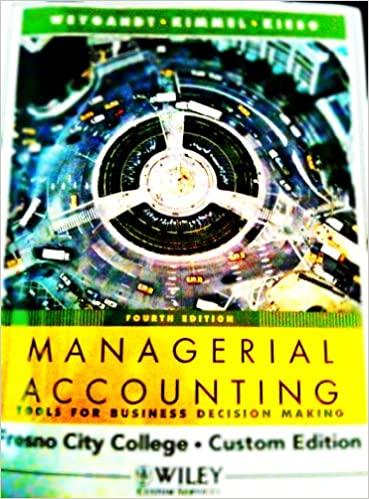Question
(ALL questions from this section must be attempted. Each question is worth 1 mark) 1. The implementation of a basic standards costing system to a
(ALL questions from this section must be attempted. Each question is worth 1 mark)
1. The implementation of a basic standards costing system to a manufacturing organisation is likely to: a. produce favourable materials usage variances b. increase product sales c. be a de-motivating factor for direct Labour employees d. cause variances over time
2. Which ONE of the following accounts is NOT included in Statement of Financial Position? a. Bank Account b. Operating expenses c. Inventory d. Accounts Payable
3. Fixed overheads, for a period are 40,000 to be absorbed into production at a rate of 27 per unit. The actual absorption rate for the production of 1,700 units was 22 per unit. Which of the following is the fixed overhead expenditure variance? a. 5 adverse b. 5 favourable c. 6,000 adverse d. 6,000 favourable
4. An operational feasibility examination is: a. An analysis of the operational system and its acceptability to future financial objectives b. The evaluation of business operations and their achievement within the required deadlines and budgets c. An inspection into the benefits and drawbacks of a system design to the current and future operations of the business d. The examination of feasibility and the business operational systems and markets
5. Which one of the following statements is true? a. When costs are less than sales revenues, losses will be greater using a marginal cost system b. Where an absorption costing system is used, unit product costs will always be a higher value c. When production is greater than sales, closing inventory is classified as a current liability d. Where costs are less than incomes, profits will be lower using a full (absorption) cost system
6. A company had sales for the year of 262,800. The trading operations produced a gross profit margin of 48%. Calculate the cost of sales value. a. 126,144 b. 130,500 c. 136,656 d. 125,565
7. Complete this statement. _____________ is the control of data inputs to ensure compliance with software processing (format) requirements and _____________ is the output control procedures over system outputs to ensure compliance with management information requirements. a. Data conversation, verification b. Verification, validation c. Documentation, validation d. Validation, verification
8. At the end of an accounting period, trade receivables (debtors) were 4,500, the inventory valuation was 1,000 and trade payables (creditors) were 3,000. The current ratio was established at 2:1. Which of the following is the correct business bank balance? a. 2,000 b. 1,500 (overdrawn) c. 500 d. 500 (overdrawn) 9. Examine the budgeted series of capital investment project cash flows shown below:
3
Year 0 (capital investment) Year 1 Cash inflow Year 2 Cash inflow Year 3 Cash inflow Year 4 Cash inflow Year 5 Cash inflow Total cash flows: The payback period for the project is: a. 3 years b. 3 years and 183 days c. 4 years and 83 days d. 5 years (80,000) 30,000 20,000 20,000 20,000 20,000 30,000
10. The present value of 6,000 receivable at the end of a 8-year period at an interest rate of 7% is (to the nearest 1): a. 3,492 b. 48,000 c. 35,826 d. 6,420
Step by Step Solution
There are 3 Steps involved in it
Step: 1

Get Instant Access to Expert-Tailored Solutions
See step-by-step solutions with expert insights and AI powered tools for academic success
Step: 2

Step: 3

Ace Your Homework with AI
Get the answers you need in no time with our AI-driven, step-by-step assistance
Get Started


